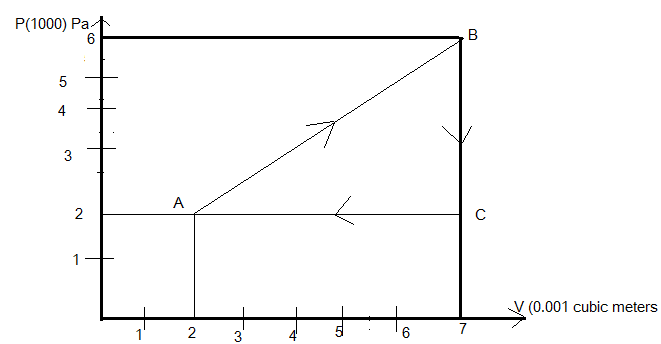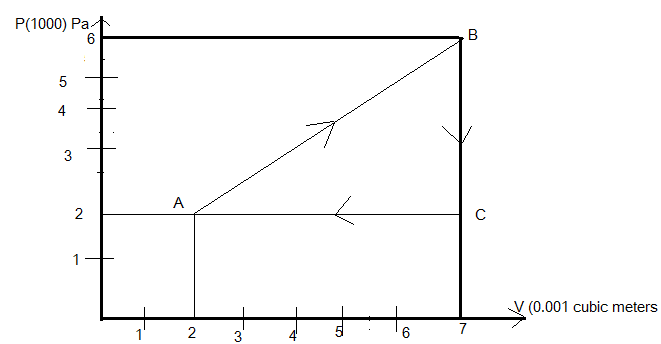
A gas is taken through the cycle A B C A, as shown. What is the net work done by the gas?

A. 3000J
B. 1000J
C. Zero
D. 2000J

Answer
575.1k+ views
Hint: The product of pressure and volume is represented by an area on the p-v diagram. The area under this curve tells us the work done during a thermodynamic process. In this process it can be found out by calculating the area of the curve this is a simple and quick method.
The curve showing the variation of volume of a substance along the x-axis and the variation of the pressure along the y-axis is the P-V diagram.
In this question first, find the total change in volume along the x-axis and change in pressure along the y-axis and then find the work done under the curve.
Complete step by step solution:
Given that the gas is going through the curve ABCA

Where the change in volume takes place from \[2 \times {10^{ - 3}}{m^3}\]to \[7 \times {10^{ - 3}}{m^3}\]along positive x-axis and pressure changes from \[2 \times {10^5}Pa\] to \[6 \times {10^5}Pa\] along the y-direction.
Hence,
\[\vartriangle V = 5 \times {10^{ - 3}}{m^3}\]
\[\vartriangle P = 4 \times {10^5}Pa\]
So the area under the curve for the total work done will be equal to
Net work is done = area under the curve A B C
\[
W = \dfrac{1}{2} \times 5 \times {10^{ - 3}} \times 4 \times {10^5} \\
= \dfrac{1}{2} \times 5 \times 4 \times {10^2} \\
= 10 \times {10^2} \\
= 1000J \\
\]
Hence the total work is done by the gas under the curve =1000J
Option (B) is correct.
Note: Students should be careful in some cases where in some cases specific volume is plotted along the x-axis instead of volume; in such cases area under the curve represents work per unit mass of the working fluid given as J/Kg.
The curve showing the variation of volume of a substance along the x-axis and the variation of the pressure along the y-axis is the P-V diagram.
In this question first, find the total change in volume along the x-axis and change in pressure along the y-axis and then find the work done under the curve.
Complete step by step solution:
Given that the gas is going through the curve ABCA

Where the change in volume takes place from \[2 \times {10^{ - 3}}{m^3}\]to \[7 \times {10^{ - 3}}{m^3}\]along positive x-axis and pressure changes from \[2 \times {10^5}Pa\] to \[6 \times {10^5}Pa\] along the y-direction.
Hence,
\[\vartriangle V = 5 \times {10^{ - 3}}{m^3}\]
\[\vartriangle P = 4 \times {10^5}Pa\]
So the area under the curve for the total work done will be equal to
Net work is done = area under the curve A B C
\[
W = \dfrac{1}{2} \times 5 \times {10^{ - 3}} \times 4 \times {10^5} \\
= \dfrac{1}{2} \times 5 \times 4 \times {10^2} \\
= 10 \times {10^2} \\
= 1000J \\
\]
Hence the total work is done by the gas under the curve =1000J
Option (B) is correct.
Note: Students should be careful in some cases where in some cases specific volume is plotted along the x-axis instead of volume; in such cases area under the curve represents work per unit mass of the working fluid given as J/Kg.
Recently Updated Pages
Why are manures considered better than fertilizers class 11 biology CBSE

Find the coordinates of the midpoint of the line segment class 11 maths CBSE

Distinguish between static friction limiting friction class 11 physics CBSE

The Chairman of the constituent Assembly was A Jawaharlal class 11 social science CBSE

The first National Commission on Labour NCL submitted class 11 social science CBSE

Number of all subshell of n + l 7 is A 4 B 5 C 6 D class 11 chemistry CBSE

Trending doubts
What is meant by exothermic and endothermic reactions class 11 chemistry CBSE

10 examples of friction in our daily life

One Metric ton is equal to kg A 10000 B 1000 C 100 class 11 physics CBSE

1 Quintal is equal to a 110 kg b 10 kg c 100kg d 1000 class 11 physics CBSE

Difference Between Prokaryotic Cells and Eukaryotic Cells

What are Quantum numbers Explain the quantum number class 11 chemistry CBSE




